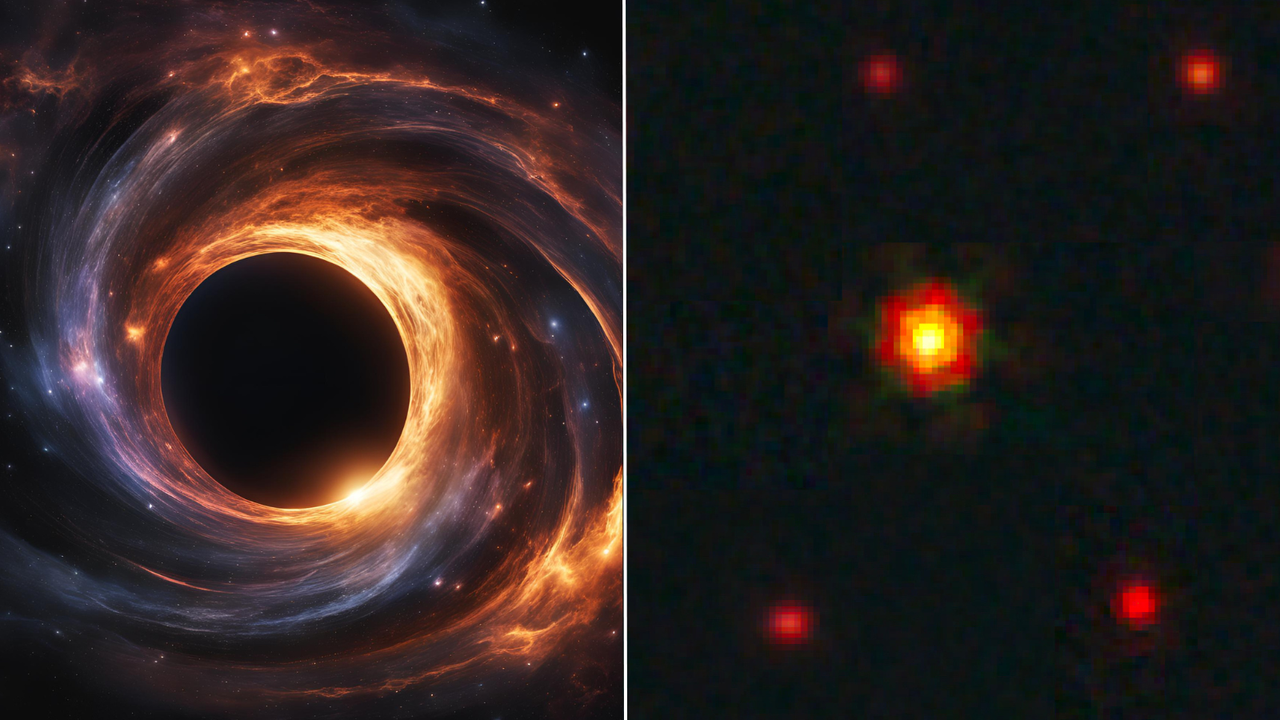
Using the James Webb Space Telescope, astronomers have discovered a ravenous supermassive black hole that existed during a period of the cosmos called "cosmic noon" that occurred around 4 billion years after the Big Bang. The discovery could further shine light on the mystery of how supermassive black holes grow to sizes of millions and even billions of times that of the sun.
This black hole is part of a collection of objects the James Webb Space Telescope (JWST) has been discovering in the early cosmos called "little red dots," mysterious specks of light that were only recently discovered thanks to the incredibly powerful infrared eye of this $10 billion space telescope. However, with a mass equivalent to 100 million times that of the sun, there is really nothing "little" about this black hole at all, with the discovery team dubbing it "BiRD," which stands for Big Red Dot.
Black holes don't emit any light themselves, in fact trapping any incident light due to their immense gravitational influence, but when these cosmic titans are surrounded by a wealth of matter upon which they are feeding, this material and jets blasted out from the poles of the black holes create a very conspicuous and bright object called a quasar. These can be seen from vast distances; for example, the light from BiRD has been travelling to Earth for 10 billion years.
BiRD was spotted in the region of the sky around a previously known quasar called J1030+0524 (J1030), itself a feeding supermassive black hole located around 12.5 billion light-years from Earth. This region of the sky has been well studied by astronomers — including this team, which hails from the National Institute for Astrophysics (INAF). However, it was while carefully analyzing images and spectra obtained with the JWST's Near-Infrared Camera (NIRCam) instrument that the research team detected an unusual source of light. A bright point in infrared that had never been revealed by prior X-ray and data.
"Starting from the calibrated images, a catalog of the sources present in the field was developed. It was there that we noticed BiRD: a bright, point-like object, which, however, was not a star and did not appear in the existing X-ray and radio catalogs," Federica Loiacono, team leader and INAF research fellow, said in a statement translated from Italian. "I analyzed its spectrum, which tells us about the chemical composition and some of the physical properties of the object."
This is possible because elements absorb and emit light at specific and characteristic frequencies. This means that the elements leave their "fingerprints" in wavelengths of light, or spectra.
"We found clear signals of hydrogen — in particular the line called Paschen gamma, a luminous signature that reveals the presence of ionized hydrogen — and helium, also visible in absorption," Loiacono said. "These details allowed us to estimate the distance to BiRD, discovering that it is relatively close to us compared to most of the little red dots known to date. Also from the analysis of the spectrum of this source, we were able to estimate the mass of the central black hole: about 100 million times that of the sun."
Little red dots are very compact objects with curious spectroscopic characteristics. Many possible theories exist surrounding these bodies, including a recent suggestion that they could be a new class of celestial body called "black hole stars." One of the prevailing theories posits that little red dots are feeding and growing supermassive black holes. The problem with this concept is the fact that the region around ravenous black holes should emit strongly in the X-ray region of the electromagnetic spectrum, but that doesn't seem to be the case for little red dots or for BiRD.
One possible explanation for this is that little red dots are the massive black hole "seeds" from which supermassive black holes grow and are therefore still shrouded by thick shells of gas and dust, shrouds that absorb high-energy X-ray radiation while allowing low-energy infrared light to slip through.
But even among the known little red dots, BiRD is a strange example.
"Before BiRD, only two other little red dots with the same spectral characteristics, including helium lines and Paschen gamma rays, were known at this same cosmic distance," Loiacono explained. "Comparing the spectral properties of BiRD with those of the other two, we found strong similarities: the line widths, absorption, black hole mass, and gas density are very similar. This led us to conclude that BiRD belongs to the same family as little red dots."
In addition to the discovery of BiRD, this research could change how scientists think of little red dots and, in turn, the growth and evolution of supermassive black holes. It was previously thought that these objects would have started to disappear as cosmic noon rolled around approximately 11 billion years ago. However, this team performed a calculation estimating the abundance of little red dots during cosmic noon, finding them to still be numerous during this cosmic epoch.
"The challenge now is to extend the study to a larger number of nearby LRDs, which we can study in greater detail than distant ones, to build a more complete picture," Loiacono concluded. "JWST has opened a new frontier in extragalactic astrophysics, revealing objects we didn't even suspect existed, and we're only at the beginning of this adventure."
The team's research was published on Thursday (Oct. 30) in the journal Astronomy & Astrophysics.







